For three out of four Swedes, the news media is their primary source of information about the new coronavirus. In terms of the visibility of different professional groups in the media coverage, Swedes have the highest confidence in doctors and researchers, while there is a lower level of confidence in government officials. These are the findings of a new survey undertaken by the Swedish non-profit organisation VA (Public & Science).
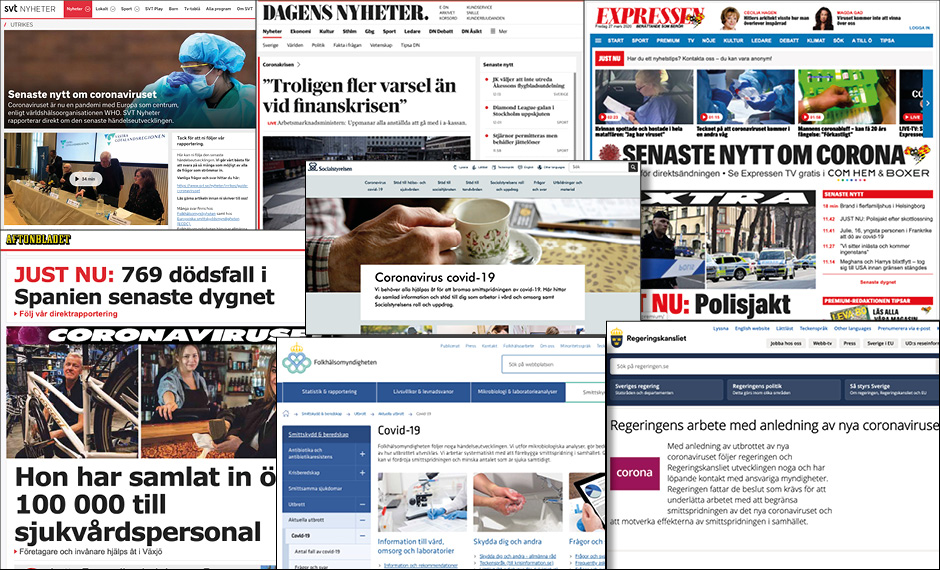
Research resources and communication efforts are being mobilised worldwide to reduce the harmful effects of the new coronavirus. In this global emergency, people are faced with making lots of decisions based on a growing, but often limited evidence base. How does the Swedish public view the way different professional groups are communicating about the coronavirus? Which sources are people using to get their information and how much confidence does the public have in various types of spokespeople?
In collaboration with researchers at the Karolinska Institute and Södertörn University, VA (Public & Science) is conducting a study of how people are receiving and interpreting information about the coronavirus and the ongoing pandemic.
News media is the primary source of information
The first survey was conducted between 18-21 March and shows that for three out of four Swedes (76 percent) the news media is their primary source of information about the virus.
Only 12 percent access information primarily from the government agencies’ communication channels. Among the four percent responding “other”, many cite their employers as their primary source of information. Other channels, such as social media discussions and Internet forums, do not appear to be very common sources of information.
Among people aged 65 and above, a significantly higher proportion (92 percent) mainly follows the news media, whereas government agencies’ own channels are the main source of information for just four percent of this age group.
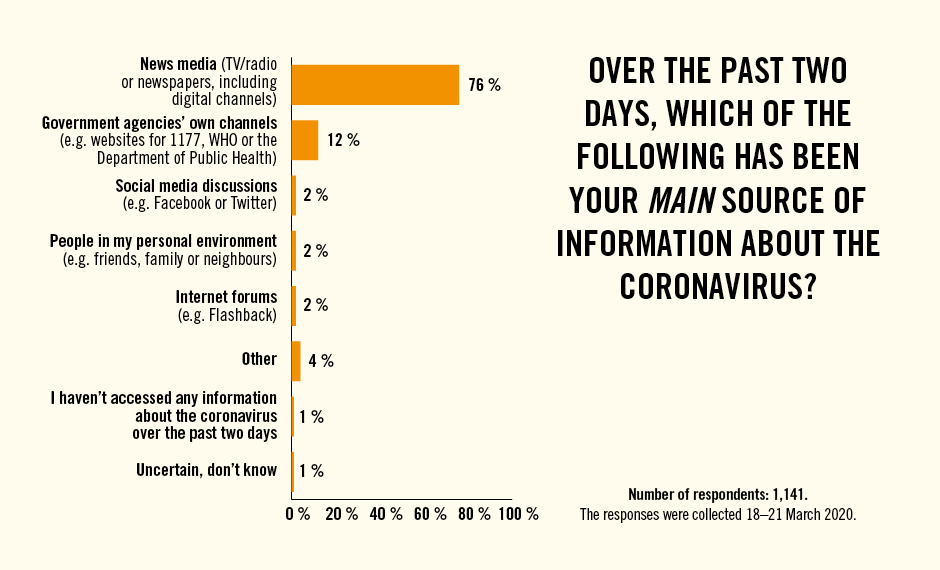
TV is the most common channel
For the majority of Swedes, television is the most common channel for information about the coronavirus, in particular SVT (Swedish Television), the Swedish public service broadcaster, which 72 percent of respondents had watched in the preceding two days.
The most common newspaper is the tabloid Aftonbladet, which four out of ten people (39 percent) have got information from. The larger morning newspapers reach a smaller proportion overall: One in five (20 percent) have accessed information from Dagens Nyheter (DN) and 11 percent from Svenska Dagbladet (SvD).
However, among people with post-secondary school education, the morning newspapers are more common sources of information about the coronavirus (27 percent for DN and 16 percent for SvD).
A relatively large proportion, 15 percent, have also accessed reporting on the coronavirus in the foreign/international news media. Here, we can see a clear difference between men and women, with 21 and 10 percent respectively accessing foreign news.
Those aged 65 or older get more of their news from TV (both SVT and TV4), Sveriges Radio (the Swedish public broadcaster) and local morning newspapers compared to other age groups. On the other hand, they are less likely to read the tabloids.
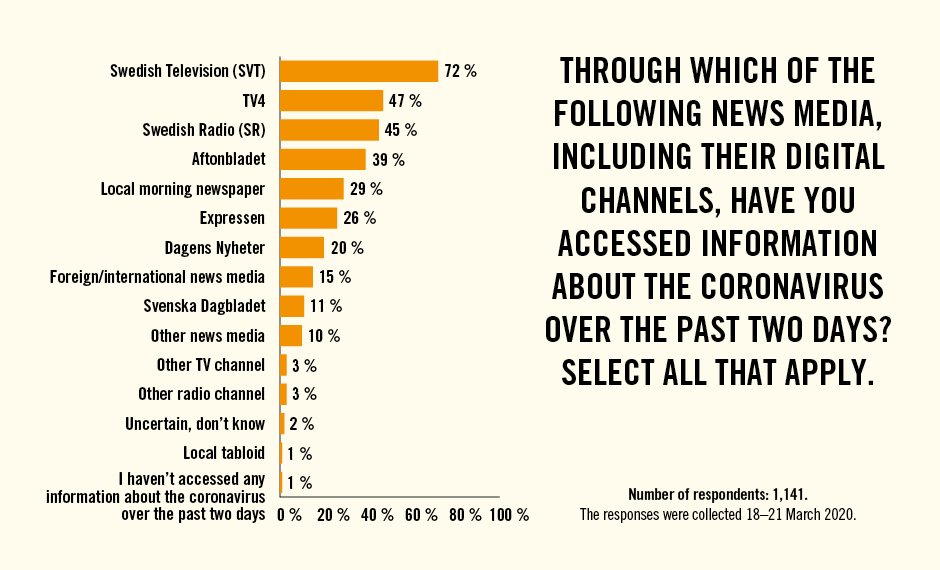
Hyped tone of reporting
Two-thirds of respondents (67 percent) perceive the tone of reporting on the coronavirus in the Swedish news media as fairly or very hyped/alarmist, while only 5 percent consider it to be fairly or very cautious/watchful.
People aged 65 or older have the lowest proportion that perceive the tone to be fairly or very hyped/alarmist (61 percent). The highest proportion can be found in 50-64 year olds (73 percent).
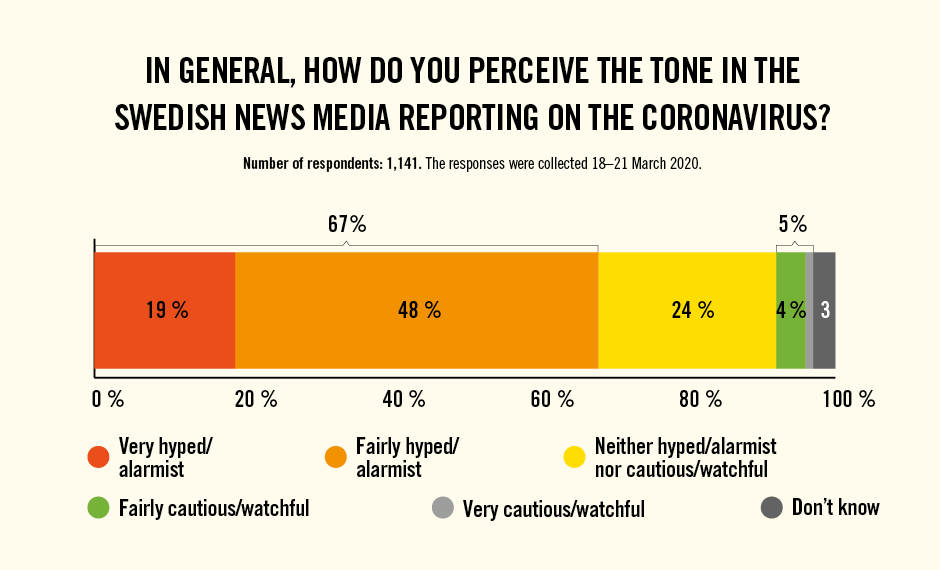
High confidence in healthcare professionals and researchers
In the Swedish news media, there are a number of professional groups that comment on the coronavirus and the ongoing pandemic. Here we can see that more than nine out of ten (91 percent) of Swedes say they have fairly or very high confidence in doctors and other healthcare professionals.
Researchers who speak publicly about the coronavirus also enjoy a high level of confidence, with a corresponding proportion of 87 percent.
Confidence is lower in people connected to government agencies: 60 percent of Swedes have fairly or very high confidence in government officials when they speak about the coronavirus in the Swedish media.
We see significantly lower confidence in politicians (33 percent) and journalists (17 percent).
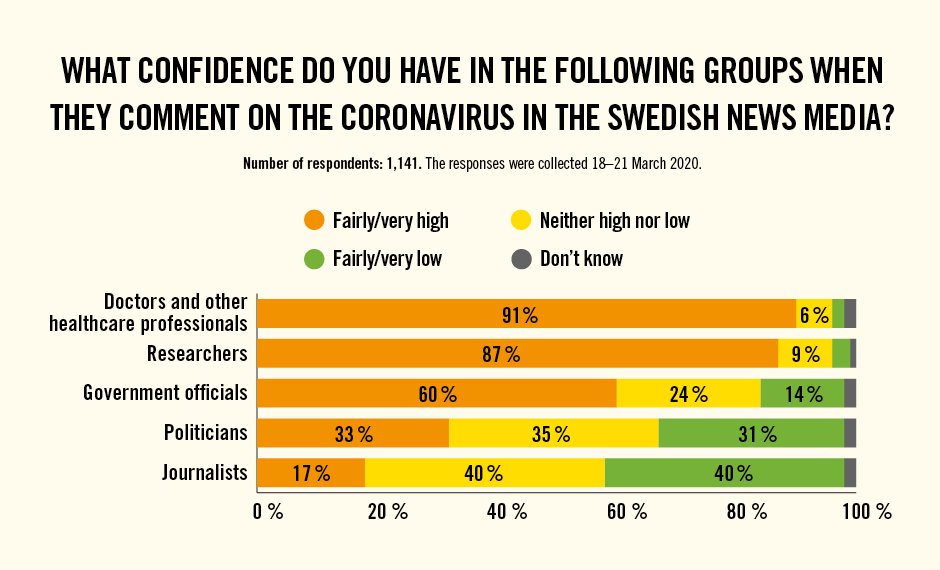
Ongoing studies
In order to monitor the Swedish public’s news consumption, confidence in key professional groups and attitudes towards media reporting over time, we intend to conduct further studies during the course of the pandemic. We also plan to undertake a content analysis of reporting on the coronavirus and the covid-19 pandemic in the Swedish media in order to map any changes in reporting during different phases, and how this relates to public attitudes during the same time period. Read more about VA’s study.
We are keen to hear from organisations undertaking similar studies in other countries. For more information about the study, please contact Gustav Bohlin, a researcher at VA. If you are interested in collaborating or supporting us in the study, please contact Cissi Askwall, Secretary General of VA.
About the survey
The first part of the survey outlined above was undertaken by the market research company Kantar Sifo and consisted of 1,141 interviews with a web panel based on random sampling. The interviews were conducted between 18-21 March 2020. The results are weighted based on gender, age and region of residence.
